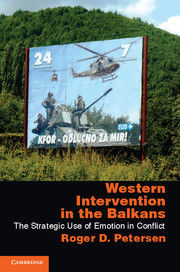Book contents
- Frontmatter
- Contents
- Acknowledgments
- Part 1 Background and Theory
- Part 2 Cases and Tests
- 7 Background to Western Intervention in the Balkans
- 8 The Case of the Roma in Kosovo
- 9 Background to Kosovo
- 10 Waiting for the West
- 11 Kosovo Intervention Games, I
- 12 Kosovo Intervention Games, II
- 13 Kosovo Conclusions
- 14 South Serbia
- 15 Macedonia
- 16 Bosnia
- 17 Montenegro
- 18 Conclusion
- Appendix A A Note on Names
- Appendix B Alternative Arguments
- References
- Index
- References
7 - Background to Western Intervention in the Balkans
from Part 2 - Cases and Tests
Published online by Cambridge University Press: 05 June 2012
- Frontmatter
- Contents
- Acknowledgments
- Part 1 Background and Theory
- Part 2 Cases and Tests
- 7 Background to Western Intervention in the Balkans
- 8 The Case of the Roma in Kosovo
- 9 Background to Kosovo
- 10 Waiting for the West
- 11 Kosovo Intervention Games, I
- 12 Kosovo Intervention Games, II
- 13 Kosovo Conclusions
- 14 South Serbia
- 15 Macedonia
- 16 Bosnia
- 17 Montenegro
- 18 Conclusion
- Appendix A A Note on Names
- Appendix B Alternative Arguments
- References
- Index
- References
Summary
By the early years of the twenty-first century, the United States and Western Europe (collectively referred to as “the West” in this book) were deeply involved in interventions across almost every region of the Western Balkans. They were carrying out the Dayton Agreement and its special annexes in Bosnia, conducting an occupation of Kosovo, supervising the Ohrid Accord in Macedonia, brokering an agreement in South Serbia, temporarily keeping Serbia and Montenegro together with the Belgrade Agreement, and assisting with other accords in Montenegro. Despite major differences in the scope and nature of these interventions, they had a common approach based in Western rationality. The West had developed an intervention style with features similar to the “games” in academic game theory. That game style approach is the subject of Chapter 3. The purpose of this chapter is to describe the evolution of Western–Balkan interactions that led to that approach.
First, a brief historical background of the former Yugoslavia, necessary for understanding crucial aspects of Western intervention, is provided. The empirical sections of the book will supply more detailed background for each specific case. Second, the period from 1990 to 2005 is treated in three stages, each marking significant transformations in the West's approach to the region.
- Type
- Chapter
- Information
- Western Intervention in the BalkansThe Strategic Use of Emotion in Conflict, pp. 107 - 129Publisher: Cambridge University PressPrint publication year: 2011

